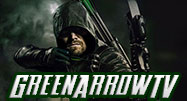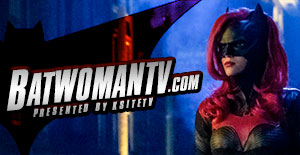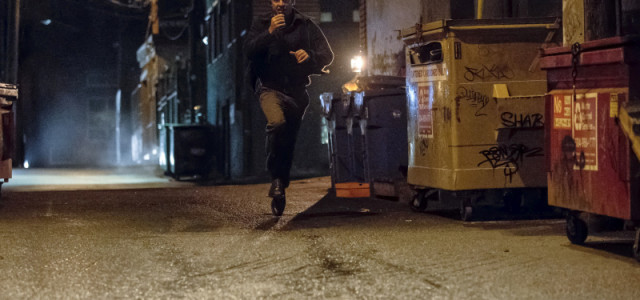
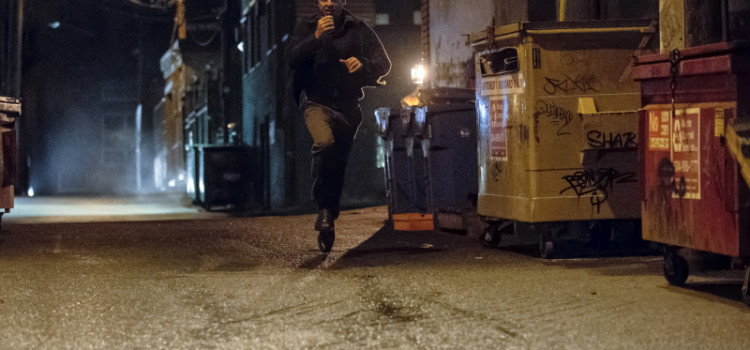
Arrow #2.3: “Broken Dolls” Recap & Review
Recaps & Reviews October 24, 2013 Matt Tucker

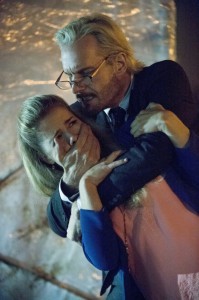 Summary: A crammed yet spirited hour filled with all-new story directions, tons of comic references, heroics, and Lances.
Summary: A crammed yet spirited hour filled with all-new story directions, tons of comic references, heroics, and Lances.
If you have not seen this episode yet and do not wish to be spoiled, do not continue reading!
Recap
Quentin Lance enlists the help of the Arrow to pursue Barton Mathis, a serial killer referred to as the Dollmaker for the type of victims he chooses and his method of killing them who Lance had obsessively pursued and captured following Sara’s death. Mathis escaped from prison during the earthquake and has started killing again. Meanwhile, the Arrow is rescued from Laurel’s trap by a mysterious blonde woman in black and a mask who has been attacking men hurting women in the city. The Arrow has Roy pursue leads in the Glades to find the woman, who is running from a shadow league of assassins with possible ties to Malcolm Merlyn. Lance and Laurel are abducted by the Dollmaker and both the Arrow and the female vigilante intervene. On the island, the men on the boat attack the downed plane basecamp while Oliver and Slade are away trying to recon the boat. Oliver rushes to help Shado, catching both he and Slade in the shelling. An unconscious Oliver awakes in a cage in the hold of the ship, which is on its way away from the island.
For a full recap of this episode, visit our handy episode guide.
Review
Let’s just dispense with the most obvious commentary about this episode right at the top. This is, without doubt, the single most DC Comics-chocked hour of television in the history of the medium, any animation aside. Certainly, it takes that title from the kitschy but cool two-part event from the ninth season of Smallville, Absolute Justice, which also happened to feature this episode’s director, Glen “Nuclear” Winter (maybe, maybe not?), sharing those duties with series star Tom Welling. (Winter on first part “Society,” and Welling on second half “Legends.”) As much as anyone, particularly as an influential Director of Photography on both series, Winter is responsible for bringing much of the DCU to live-action, and here he does it with aplomb. See Odds & Ends below for the various references in this hour alone.
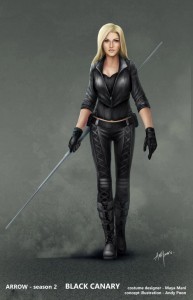 The most iconic and relevant to the mythos of the source character for this series is the meeting of the Emerald Archer and a certain “birdie.” What is most interesting about the Canary’s introduction is that for all of the talk about being a proto-version — much like Yao Fei portended Oliver’s vigilante persona, and Billy Wintergreen gave us our first taste of Deathstroke — likely to set Laurel up in the role later on, this one seems rather fully formed. She’s got the costume, she’s got the skills, she’s got the tools, and now, she’s got the Arrow’s attention. There is so much about this character that is Black Canary that one has to wonder why any transition to Laurel would be necessary, if it even comes to pass.
The most iconic and relevant to the mythos of the source character for this series is the meeting of the Emerald Archer and a certain “birdie.” What is most interesting about the Canary’s introduction is that for all of the talk about being a proto-version — much like Yao Fei portended Oliver’s vigilante persona, and Billy Wintergreen gave us our first taste of Deathstroke — likely to set Laurel up in the role later on, this one seems rather fully formed. She’s got the costume, she’s got the skills, she’s got the tools, and now, she’s got the Arrow’s attention. There is so much about this character that is Black Canary that one has to wonder why any transition to Laurel would be necessary, if it even comes to pass.
More important, she’s got the makings of an intriguing backstory. That’s without even getting into all of the implications of her true identity, which in reality have, to this point, been pure behind-the-scenes postulations than anything shown on-screen. For all the talk of the Arrow being a small-screen proxy of the Christopher Nolan version of Batman, Canary’s story appears to be the more Dark Knight influenced, as she has clear ties to Ra’s al Ghul’s League of Assassins. The introduction of one such member in the exact same outfit as the Dark Archer seems to definitely answer the question of who the man was in Nanda Parbat that Malcolm Merlyn met and changed his life. The connection also gives stronger resonance to the crazy plan of the Undertaking.
(As an aside, though the current live-action pronunciation of al Ghul’s name is phonetically — and likely culturally — correct, I learned to say that name as “Raysh owl Gool.” The character’s creator, Dennis O’Neil, has always referred to him in this manner, so I defer to the master. But I bring up the point because the pronunciation and set-up here imply a connection to the Dark Knight Trilogy version, which makes for an odd position if and when Arrow has any ties to the currently-establishing DC Movie Universe and its decidedly different take on Batman. Though, it would appear the group on the show takes its name from the original comics inspiration and not the ominous League of Shadows from Nolan’s world, so this could all be superficial.)
Canary’s meet-violent with the Arrow — so thankful we can finally start calling him that instead of the Hood, vigilante, or some variation of hooded guy — was a splendidly vibrant way to introduce the character. One kind of wishes we didn’t already have the tease from the end of “City of Heroes” and were thrown this woman fresh, but establishing the connection with Roy earlier helps to serve the story better, paying off later in this episode. Still, after the completely brain-twisting predicament the Arrow was placed in at the end of last episode, Canary coming to his rescue in thrilling fashion was both surprising and yet absolutely the answer to the puzzle, even though her motives aren’t quite clear yet. They give her a very distinct M.O., targeting men who bring harm to women, so it’s not entirely evident why she was both keeping tabs on the Arrow’s movements and following him in this instance. Perhaps she feels he plays his own role in protecting the city. Or perhaps she’s just quite aware of the Arrow’s true identity. All will be revealed shortly, but in-episode, the rescue didn’t quite fit with her stated actions. Rationality aside, the sonic device she carries, though inspired by something similar from the comics at one point if I recall, is a practical and inventive way to incorporate the vaunted Canary Cry, an actual superpower of the comic version of Dinah Laurel Lance, and it just makes for one hell of a cool scene.
All in all, one could drone on and on about Canary, but she is quite simply bad ass. That her methods include lethal disposal of her targets oddly puts her on a similar level to the Hoods gang, and that places her in direct conflict with Oliver, which should make for a fiery dynamic as the two continue to cross paths and her identity is revealed. It’s but one of many plot threads that kicks into high gear during this hour.
In fact, even with its strong pace, “Broken Dolls” is a rather dense episode for both story and character. Even tiny moments such as Roy complaining about the Canary hitting him in the face with her staff and his worry about Thea discovering his lie about his alternate life as a result have compelling consequences overall. For as much as we’ve talked about the blistering pace and plotting of the first season, the first three episodes this year are some of the most story-rich you’ll find on television currently.
This includes the stunning developments of the island timeline. Though a bit oddly handled in numerous quick “pockets” throughout the episode, what seems like a rather straightforward recon mission and heart-to-heart between Ollie and Slade rapidly alters the status quo. Just as answers come about Malcolm and Ra’s al Ghul, the persistent question of whether or not Ollie spent all five years on the island is answered in bold underline. With Oliver captured and stowed on the boat, the fact that it’s trawling away out of the harbor opens up huge possibilities. Is he being taken to Russia or some island near the Russian and China coasts that finally involves him with the Bratva mob? Does taking him away from the island, possibly for a significant period of time, force the rift between Oliver and Slade when Oliver finally returns to find the likely now-disfigured Slade? Did Shado somehow survive the bombardment on the plane, and will she appear on the boat with Oliver or be left to struggle on the island with Slade? Some many questions and scenarios presented, and it was thoroughly unexpected how much shift could occur and how could quickly things could change.
The immolation of Slade Wilson scene has to rank as one of the most thoroughly startling and disturbing moments of the series to date. Even after the fairly rote moment where Oliver saves Slade from sliding down a cliff, it’s hard to imagine anyone could’ve guessed at such a turn. It’s quite effective both in the visual and in the heartbreaking consequences. It appears to answer why Slade would eventually take to wearing his specialty ASIS mask on a long-term basis and gives an even more cogent explanation as to why these two brothers-in-arms would possibly be turned against one another, one that has greater stakes than a simple love triangle. Overall, it’s a masterful switch that demonstrates how well this creative team plays with audience expectation. That it’s preceded directly by one of the more visceral action sequences of the series adds to its effectiveness.
That scene of Oliver dodging the shelling from the boat in a desperate attempt to get to the plane, to get to Shado, with Slade just as desperately trying to save his young friend was yet another feather in the cap of Winter. It represents one of a number of wonderful set-ups throughout the episode, which includes a thoroughly engaging and kinetic footchase through an impound lot between Roy and Canary cohort Sin (Bex Taylor-Klaus), as well as the kicker of a set-piece of Canary’s opening rescue and her later fight — descending onto the scene in grand fashion from a hanging black scrim — with the Dollmaker. One of the exciting things about your DP also taking on main director duties for the hour is the willingness to experiment with the look, feel, and overall energy, but at the same time not losing or destroying the overarching tone and milieu already created for the show. Winter delivers an exciting chapter that continues a wonderful artistic uptick this season on what was already exceptional technical achievement in the first year.
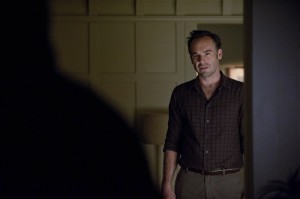 Beyond technique, heroics, and flashbacks, this episode really is a Lance family one. Kudos to both Paul Blackthorne and Katie Cassidy for some of the strongest work for both of their characters to date. There is a great thrill to be had with Quentin Lance now explicitly working with Team Arrow. Seems safe to say that it will be some time before we see Quentin in the Arrowcave at the foundry, if ever, but having a fourth member and someone in law enforcement fits like a glove. The rather personal nature of this particular case against Barton Mathis, aka the Dollmaker, lends Lance more of a special consultant capacity to the efforts rather than full-time, but it was nice to see him defending the vigilante to Laurel and his reluctant but appreciative acceptance of Oliver’s role at story’s end. It was very smart to include the scene where both Lance and Oliver confront Mathis’ lawyer to once again show that, even with his no-kill philosophy, Oliver takes different tacks in his approach than Lance is comfortable with. That maintains a complexity for both Blackthorne and Stephen Amell to play while also giving stronger meaning to Lance’s approval of the hero in the process. Plus, he gets to be the first to voice the name of “the Arrow,” which is cool and also great symmetry with him having named him “the Hood” last season.
Beyond technique, heroics, and flashbacks, this episode really is a Lance family one. Kudos to both Paul Blackthorne and Katie Cassidy for some of the strongest work for both of their characters to date. There is a great thrill to be had with Quentin Lance now explicitly working with Team Arrow. Seems safe to say that it will be some time before we see Quentin in the Arrowcave at the foundry, if ever, but having a fourth member and someone in law enforcement fits like a glove. The rather personal nature of this particular case against Barton Mathis, aka the Dollmaker, lends Lance more of a special consultant capacity to the efforts rather than full-time, but it was nice to see him defending the vigilante to Laurel and his reluctant but appreciative acceptance of Oliver’s role at story’s end. It was very smart to include the scene where both Lance and Oliver confront Mathis’ lawyer to once again show that, even with his no-kill philosophy, Oliver takes different tacks in his approach than Lance is comfortable with. That maintains a complexity for both Blackthorne and Stephen Amell to play while also giving stronger meaning to Lance’s approval of the hero in the process. Plus, he gets to be the first to voice the name of “the Arrow,” which is cool and also great symmetry with him having named him “the Hood” last season.
Blackthorne is a treat throughout the hour, really driving home the impact of the Dollmaker’s heinous acts. Gracefully, Winter declines from focusing too much on the visual outcomes of Mathis’ kills, offering quick looks to sell the idea but not lingering as many crime procedurals and films tend to do. It’s up to Blackthore to truly sell the danger of Mathis and he nails it. A great turn by guest star Michael Eklund completes the portrait and threat without reveling in his methods and psychosis. That’s a refreshing decision by the writing and the direction.
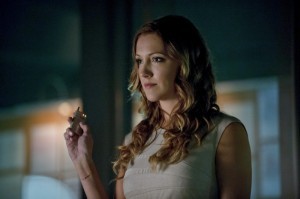 Laurel, though, comes out with the biggest character revelation, and once again the audience’s expectations are subverted. It’s hard to say whether her campaign against the Arrow is now officially stopped, but getting right to the root of her anger was another unexpected gift. I feel as though I’m echoing myself, but this deepening of Laurel’s character over these last three episodes is incalculably welcome and valuable, and it is tremendously satisfying that they didn’t drag out this discovery for her. Katie Cassidy does a terrific job digging into the emotion presented by this revelation, and it’s genuinely exciting to see what this opens up for her going forward. Again, it’s hard to know if this kills her vendetta against the Arrow, but it certainly adds more emotionally color to what had been somewhat of a flat character and might just give her a similar motivation as Tommy’s death has Oliver.
Laurel, though, comes out with the biggest character revelation, and once again the audience’s expectations are subverted. It’s hard to say whether her campaign against the Arrow is now officially stopped, but getting right to the root of her anger was another unexpected gift. I feel as though I’m echoing myself, but this deepening of Laurel’s character over these last three episodes is incalculably welcome and valuable, and it is tremendously satisfying that they didn’t drag out this discovery for her. Katie Cassidy does a terrific job digging into the emotion presented by this revelation, and it’s genuinely exciting to see what this opens up for her going forward. Again, it’s hard to know if this kills her vendetta against the Arrow, but it certainly adds more emotionally color to what had been somewhat of a flat character and might just give her a similar motivation as Tommy’s death has Oliver.
With “Broken Dolls,” Arrow is three-for-three on the season and only appears to be trending upwards. Even with the somewhat procedural structure of this episode — something for which we’ve slammed other shows recently — that harks back to the list from the first season, there is a combined narrative and character propulsion that continues to elevate the show. There is often a deference paid to (1) shows on the CW; (2) action dramas; and (3) series based on comic books. Yet, with the facility with which the Arrow creatives are guiding the show now and the engagement of everyone in the cast, including the continuing trend of phenomenal guest stars, this show is quickly stacking up amongst the best and most entertaining on television. That is said completely with the fanboy blinders off, before anyone dismisses the comment as such blather. Other shows could learn very well from its confidence, its sense of self, and its respect and admiration of the audience to not dolefully linger on tells its story.
Odds & Ends
- Just as Moira Queen’s maiden name was revealed as Dearden, offering Thea a middle name that brought her closer to the comic book character of Mia Dearden, Quentin Lance is brought closer to his comic book inspiration when his middle name is revealed to be Larry. Larry Lance was the police detective who served as love interest to the first Black Canary, Dinah Drake. Larry and Dinah gave birth to the second Black Canary, Dinah Laurel Lance.
- Officer Lance’s patrol callsign is Delta Charlie 52, a reference to both DC Comics and their frequent use of the number 52 (the Multiverse, the 52-week countdown to the Final Crisis, the New 52 reboot, etc.).
- Speaking of the number 52, the news station Oliver has Thea turn to is Channel 52, a channel offered featured in Gotham City in the comics. The reporter, Bethany Snow, is often seen on Channel 52 in the comics as well.
- Lance and the Arrow also go to apartment 52 in pursuit of Mathis, where they find the newspaper and phone he’s left for them.
- The van used to abduct Lance was from Metamorpho Chemical. Metamorpho is, of course, another hero in the DCU.
- The boat used by the pirates that Oliver is eventually held captive on is named the Amazo. Amazo is a well-known villain in the DCU.
- Roy chases Sin, another character from the comics, to an abandoned clocktower, where the Canary captures him. Black Canary has long been associated with the group Birds of Prey in the comics. The group operates out of a clocktower.
- In addition to the “Canary Cry” sonic device the Canary uses to shatter all of the glass at the DA’s office, the Canary chirp noise in the soundtrack returns when she exits the clocktower.
- Mathis’ lawyer is named after comic writer and penciler Tony S. Daniel. The Barton Mathis version of the Dollmaker was created by Daniel.
- Mathis’ appreciation of the porcelain skin of his victims — he even notes that Laurel’s skin is far more tanned than for his normal taste — speaks to the more gruesome aspect of the comic book character, who made masks of skin to wear in a fashion similar to the serial killer Jame “Buffalo Bill” Gumb in the book Silence of the Lambs and its film adaptation.
- Though not having her sonic powers, Canary’s ability to jump at certain points seems to imply she might have some supernatural ability.
- Shado’s fascination with the Japanese soldier calls out to her comic origins as a member of the Japanese Yakuza.
- Moira’s lawyer at her court proceeding is none other than Jean Loring, love interest of Ray Palmer, the DCU superhero known as the Atom. A “Ray and Jean” were mentioned by Laurel and Oliver during the pre-island flashbacks of last season’s “The Undertaking,” but it would appear these are not the same.
- It’s a fantastic treat to see more of the city of Vancouver used on location shooting. In addition to the very different locations and shots of the island, everything has a bigger scope, feel, and breadth this year.
A SECOND OPINION
by Derek B. Gayle
“Broken Dolls” had the workings of a potentially lame episode. The Lances have often been a weak spot, and a CW show presenting a gruesome serial killer story in a superhero world hasn’t always yielded the best results (how many times did Smallville attempt it without much success?) But Arrow smartly took the serial killer story and used it as a tool to expediently develop this season’s ongoing stories and delve into the Lances better than we ever had.
This entire episode is wonderfully fast-paced and tightly-woven, beginning with the episode’s explosive opening. Satisfying last week’s cliffhanger was going to be a feat, but pulling a stunt like having current Canary jump in to save Arrow from future Canary is definitely a capable way of keeping it satisfying. Caity Lotz’s mysterious Canary is a very cool figure so far, and the sonic device is a clever way to integrate the Canary Call into the show’s grounded reality. Admittedly, Caity Lotz’s petite stature (or what appears to be petite onscreen) doesn’t read terribly well as the ass-kicker she’s been portrayed as, but acting-wise she’s certainly intimidating in the final scene. Though, you might not have noticed, what with the Ra’s al Ghul namedrop. New mythology is starting to flow out, and the teases of what’s to come on this front are incredibly exciting.
To be honest, it’s almost disappointing that Laurel has overcome her bout of antagonism so early; the darker Laurel on a crusade against the Hood was a fun turn for the character. It would have been interesting to see Laurel play full-on antagonist all season, but the guilt behind her motivations were so flimsy that she’d only look like a weak character if her vendetta was carried out for too long. As it stands, Laurel had a major breakthrough in determining her guilt; Tommy’s death being “her fault” is something fans have complained about since the finale aired, and the show is not shying away from addressing that in heavy fashion. Katie Cassidy was heartbreaking as Laurel had the revelation about her guilt, even if it’s guilt we already knew about.
But for the first time, really, this is a Quentin episode. Lance and the Arrow—which Quentin named him now, apparently—is a very fun dynamic, exactly what we predicted in the early days of the show. Admittedly, it’s a little kooky that Quentin can now stand right next to Arrow for long periods of time and not figure out it’s Oliver in a hood, but hey—comic book show.
In any case, Paul Blackthorne gets lots to do, with this newfound lighter Quentin in the spotlight. Despite the demotion, Quentin feels significantly less burdened this season, as if helping save half the Glades and working with the Arrow have given him a new lease on life. Blackthorne plays Quentin with more energy, when in season one he was a guy constantly on edge, not too sober, and low on sleep. Quentin is certainly obsessive throughout this hour as he was in the first season, but it’s an understandable obsession instead of a misguided one. It’s in contrast to Laurel’s current’s vendetta, in that Quentin knows he’s after Barton Mathis because of his guilt in not catching him sooner, while Laurel is blind to her own guilt misguiding her. Quentin’s awareness of his flaws has become his strength, in a way, and the bad times he’s gone through have allowed him to more clearly see the good and the bad, and the lines that have to be crossed. It’s a great testament to the character development this show has put forth, and the Quentin/Arrow dynamic is one of the coolest things that have come out of the show.
Other fun bits sprinkled into the episode were successful too, like Roy’s collision with Canary, and the chilling portrayal of Mathis by Michael Eklund (who played the villain on one of Fringe’s best episodes, “The Plateau”) and his creepy, creative killing methods. The only story that faltered a bit was Moira’s; while the death penalty angle is dramatic, the idea that she’s hiding another deep, dark family secret related to the Undertaking feels a bit forced. But, that all depends where it goes.
“Broken Dolls” is another great episode of Arrow, taking a potentially messy concept and making it into a solid exploration into the Lance family. Paul Blackthorne excels, nailing down a character that wasn’t always terribly grounded last season, and fully capturing him as a likable character. The full debut of the Canary is still rife with mystery, and while the idea of a proto-Canary apparently associated with the League of Shadows is still kind of weird, the prospects are very, very exciting.
Matt Tucker Editor/Senior Writer/Reviewer
Matt Tucker is a stage and film actor, writer, Seattleite, comics nerd, sports fan, and aspiring person. Someday, he’ll be a real boy. He's an editor and senior writer for KSiteTV network (GreenArrowTV, DaredevilTV) and the sports blogs Sonics Rising and Cascadia Sports Network. Follow him on Twitter at @MattBCTucker or @TuckerOnSports
Arrow Reunion Picket Set For August 11
News Aug 4, 2023
Stephen Amell Is Returning To The Arrowverse!
News Jan 8, 2023
Happy Arrowversary!
News Oct 10, 2022
Mia Queen Returns For The CW’s “Armageddon”
News Aug 25, 2021
Arrow Season 8 Blu-ray & DVD Coming April 28
News Feb 5, 2020
End of an Arrow: Thoughts on the Series & Finale
News Jan 28, 2020
